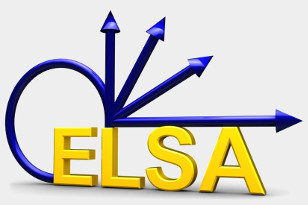
| |
| ELSA-Facility | |
| Accelerator physics: | |
| Home page | |
| Group members | |
| Accelerator | |
|
|
Research & development |
| Publications | |
| Teaching | |
| Experiments at ELSA: | |
| Hadron physics | |
| Polarized target | |
| Test beam | |
| Informations for users: | |
| Beam schedule | |
| Accelerator status | |
| SFB/Transregio 16 | |
| Radiation protection | |
| Job offers | |
| Additional links | |
| Guided tours | |
| Contact | |
 |
Deutsche Version |
Research and Development
One of the main emphases of the research activities at ELSA is the generation and acceleration of a beam of polarized electrons, which in addition is subject matter of a partial project of the collaborative research centre SFB/TR 16. It comprises, besides the further development of a dedicated source of polarized electrons which is based on the photoemission out of strained layer superlattice GaAs-like crystals, the application of a sophisticated scheme for the correction of depolarizing resonances during post-acceleration in the stretcher ring. In order to allow for a quick examination of the effectiveness of the applied corrections, a polarimeter based on Compton backscattering of circularly polarized laser photons off the stored electron beam was developed and is currently being set up.
In addition, a design study on the feasibility of an energy upgrade up to 5 GeV is being worked out. Part of the research program at Bonn focuses on the acceleration and storage of high beam currents in circular accelerators. Research studies on a significant increase of the internal current of the ELSA stretcher ring represent an integral part of the continuation of the accelerator physics research within the SFB/TR 16 and comprise, besides the investigation of the causes of collective beam instabilities, the development of dedicated beam diagnostics and the construction of sophisticated feed-back systems in order to actively damp these instabilities. Part of these investigations are carried out within the Bonn contribution to the accelerator research program of the Helmholtz Alliance Physics at the Terascale, which was established at DESY in 2007.
In detail, the current accelerator physics research activities at ELSA are the following:
 Polarized Electrons:
Polarized Electrons:
- Development of pulsed sources of polarized electrons
Development, construction, and set up of the hardware operated in extreme vacuum conditions (gun, preparation chamber, load lock system) and the required laser systems, in situ investigation of the properties of different types of photocathodes in view of increasing the maximum emission current and beam polarization, development and test of novel techniques of photocathode heat cleaning and preparation. - Acceleration of polarized electrons in circular accelerators
Calculation of depolarizing resonance strengths (numerical integration, spin tracking), development and set up of a new magnet system to correct for closed orbit distortions on the fast energy ramp, compensation of depolarizing resonances by applying harmonic closed orbit correction and betatron tune jumps utilizing pulsed quadrupole magnets.
 Slow Beam Extraction:
Slow Beam Extraction:
- Optimization of the extraction optics
Numerical simulations and experimental investigations on the influence of the transverse and longitudinal tunes and the chromaticity on the characteristic parameters of the external beam (emittance, beam pointing stability, time structure). - Enlargement of the current regime
Extraction of low beam currents in the femtoampere regime required for detector testing, extraction of high beam currents (1 - 10 nA), active beam position stabilization. - External beamline for testing of detectors
Development and set up of a new beam extraction and external beamline which allows for an adjustment of beam parameters over a wide range (current and beam width).
 Beam Diagnostics:
Beam Diagnostics:
- Techniques for measuring the accelerator tunes
Development and set up of pulsed dipole magnets (tune kickers) in order to excite coherent beam oscillations on the fast energy ramp, spectral analysis of the beam oscillations, periodic excitation of longitudinal and transverse beam oscillations by stripline kickers and phase modulation of the accelerator RF, phase sensitive analysis of the beam oscillations based on lock-in techniques. - Techniques for measuring the beam intensity distribution in phase space
Development and construction of a high resolution synchrotron light monitor (detection of the UV component) to measure the transverse beam intensity profile, development and construction of a broad band wall current monitor to measure the longitudinal beam intensity profile. - Polarimetry of the stored electron beam
Development, set up, and optimization of a Compton polarimeter, based on a 2x20 W disk laser and a counting silicon strip detector (768 channels, each channel equipped with amplifier, discriminator and event counter, developed in close collaboration with the ATLAS pixel group of Prof. Dr. Wermes). - Techniques for measuring beam intensity, position and profile at low beam currents
Measurement of the beam current in the femtoampere and the beam position in the picoampere regime utilizing harmonic cavities and lock-in amplifiers, measurement of the transverse beam profile in the picoampere regime with synchrotron light monitors.
 Acceleration and Storage of high Beam Currents:
Acceleration and Storage of high Beam Currents:
- Single-bunch operation of the stretcher ring
Upgrade of the first linear accelerator with regard to a single pulse generation and single bunch operation, set up of a single bunch accumulation in the stretcher ring. - Causes of collective beam instabilities
Numerical simulation of coupling impedances of the ELSA vacuum chambers, numerical simulation of the higher order modes of the accelerating cavities (type PETRA), spectral analysis of coherent beam oscillations in single- and multi-bunch operation. - Techniques for HOM-suppression of the accelerating cavities
Determination of all harmful HOM'2019s, investigation of the influence of the operating temperature on the HOM's, development of dedicated HOM couplers. - Active damping of coherent beam instabilities
Development, set up, and optimization of a broad band feedback system in order to damp longitudinal and transverse beam instabilities.
 Printer version
Printer version
|
 Deutsche Version
Deutsche Version
|
Imprint | Data privacy statement |